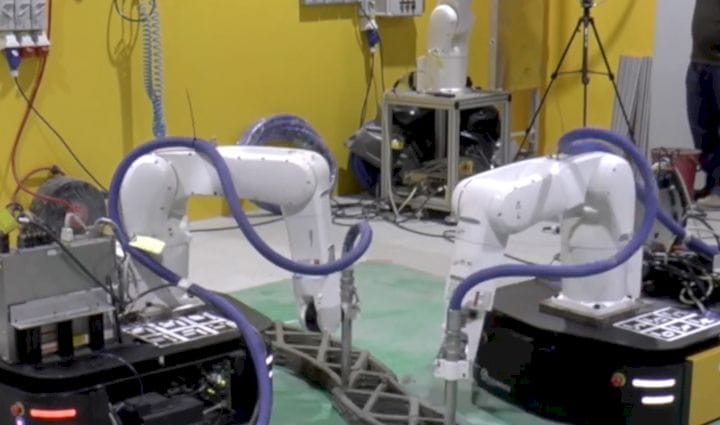![A new way to practically 3D print buildings? [Source: Nanyang Technological University]](https://fabbaloo.com/wp-content/uploads/2020/05/image-asset_img_5eb0a5b73b996.jpg)
New research from Nanyang Technological University in Singapore may signal a shift in how construction 3D printing is done.
Up to now virtually all construction 3D printing approaches have been through the use of a single massive – and I mean building-sized massive – 3D printer extruding concrete mixtures of various types. These giant contraptions have been able to extrude solid walls for building experiments in record time, although they produce only the walls, leaving the HVAC, plumbing, electrical, windows, finishes, flooring, roofing, fixtures and more to conventional means.
But there is a problem in this approach: it’s hard to set up the construction 3D printers, as they are massive. They often require assembly onsite by technicians, and once in place they don’t really move much, if at all. They must “reach” all portions of the building being printed from their original position.
Some have proposed using networks of such massive machines placed side by side to increase the reach. I suspect that’s likely impractical simply due to the cost of the enormous machines.
Now there seems to be another approach developed by the Singapore researchers. Instead of using large singular 3D printers, they attempted to use a “swarm” approach involving a number of smaller devices working in parallel on the same project.
![Dual robotic construction 3D printers [Source: Nanyang Technological University]](https://fabbaloo.com/wp-content/uploads/2020/05/image-asset_img_5eb0a5b7a0c40.jpg)
As this is a research project, the “swarm” consisted only of two robotic 3D printers, but their point is made: it is possible to have robotic 3D printers working on the same print simultaneously.
Evidently they’ve developed a 3D model slicing system that not only develops the GCODE but also somehow divides the work between the two (or potentially more) robotic 3D printers to work independently on the build. This likely involved creation of a sophisticated collision simulation system, something that’s been done on some smaller 3D printers using independently moving extruders.
The other fascinating aspect of this research is that the robots are in fact mobile. This is a significant difference from traditional construction 3D printers that are stationary. The mobile 3D printers must somehow gauge with precision their exact position and enable them to resume extruding at the correct points. I’m not sure I’ve seen this technology anywhere else and if so it could be game changing.
That’s because it would enable the swarm elements to move about the project arbitrarily, essentially extending the build volume to infinity. I can visualize dozens of such machines leapfrogging over each other to work on a project.
The smaller machines likely mean they could potentially be less expensive per unit. Thus you could deploy a squad of them to work on a project, and they would quickly finish the job in parallel. There may even be advantages in completing the job faster as there are time limits on using a truck full of fresh concrete mix.
![3D printed concrete wall [Source: Nanyang Technological University]](https://fabbaloo.com/wp-content/uploads/2020/05/image-asset_img_5eb0a5b8231fa.jpg)
One issue with smaller 3D printers of this type is that their vertical reach may be limited. How can the robots be moved to higher vertical positions, beyond their normal reach? Perhaps this could be done with secondary lift systems on which they could ride. Or perhaps with larger robotic systems, but then it would be more expensive.
I’d like to see more experiments with this approach, particularly involving much larger numbers of machines to test the collision systems on more complex situations and also to evaluate the speed factors more closely.
If this proves successful, we may be seeing the beginning of the “right” way to perform construction 3D printing for the future.











COBOD’s BOD2 construction 3D printer seems to be catching on as the company has made multiple sales of the new device.